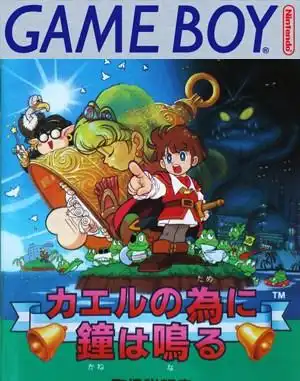Kaeru no tame ni Kane wa Naru (EN): Nintendo's Quirky Game Boy RPG Gem
Ever stumble upon a classic game that feels like a hidden treasure, even decades after its release? For many retro enthusiasts, that feeling perfectly describes Kaeru no tame ni Kane wa Naru (EN). Known officially in English fan circles as The Frog For Whom the Bell Tolls, this charming 1992 Game Boy title from Nintendo and Intelligent Systems is far more than just another handheld RPG from the era. It's a delightful, often hilarious adventure packed with unique mechanics and a story that's anything but typical.
While it remained a Japan-exclusive release for years, its reputation grew, thanks in part to character cameos in other beloved Nintendo titles. Today, thanks to dedicated fan translations, English-speaking players can finally experience the full magic of this quirky quest. Let's dive into what makes this game a standout classic and why you should absolutely give it a try.
What is Kaeru no tame ni Kane wa Naru?
Released in 1992, Kaeru no tame ni Kane wa Naru hit the Japanese Game Boy scene with little fanfare internationally. Developed by the talented folks at Nintendo R&D1 and Intelligent Systems (the minds behind Metroid, Fire Emblem, and Advance Wars!), it shares a similar engine with The Legend of Zelda: Link's Awakening, which came out later. This connection is immediately apparent in its visual style and top-down exploration segments.
The game's title is a clever Japanese twist on Ernest Hemingway's novel, For Whom the Bell Tolls, itself a reference to a John Donne poem. The "Kaeru" part means "frog," hinting strongly at the game's central transformation mechanic. For years, playing it required knowledge of Japanese or relying on guides. However, a high-quality English fan translation released in 2011 finally opened the door for a global audience to appreciate its charm.
The Story: A Royal Rumble with a Twist
Our tale begins in the peaceful Sablé Kingdom. You play as the unnamed, rather naive Prince of Sablé. One day, news arrives: the beautiful Princess Tiramisu of the neighboring Mille-Feuille Kingdom has been kidnapped by the evil King Delarin! Naturally, the Prince decides to be the hero.
However, he's not the only one with heroic aspirations. His friendly rival, the more capable Prince Richard (yes, that Prince Richard, who you might recognize!), also sets off to rescue the princess. Their journey quickly goes sideways when they both encounter a strange witch and are turned into frogs!
This isn't just a temporary setback; transformations become a core part of the adventure. The Prince of Sablé must navigate a world filled with bizarre characters, solve puzzles using his changing forms, and uncover the truth behind King Delarin's plot, all while competing with Richard and trying to become human again. The narrative is lighthearted, full of witty dialogue, and doesn't take itself too seriously, featuring meta-humor and memorable NPCs like the thieving Jam and the eccentric Mad Scienstein.
Gameplay: Auto-Battles and Shapeshifting Fun
One of the most unique aspects of Kaeru no tame ni Kane wa Naru (EN) is its combat system. Unlike traditional RPGs where you enter a separate battle screen and issue commands, encounters happen automatically the moment you touch an enemy on the map. A dust cloud appears, and the outcome is determined instantly based on your stats versus the enemy's.
- Automatic Combat: Touch an enemy, and the fight resolves. Stronger characters might defeat weaker foes instantly.
- Items & Running: You can use items or attempt to run away during these brief encounters, adding a layer of strategy despite the automatic resolution. Losing sends you back to the last hospital visited, but you keep your money and items (though health is reduced).
- Two Perspectives: The game features two distinct movement styles:
- Top-Down: Used for overworld maps and towns, similar to Link's Awakening, where bumping triggers combat.
- Side-Scrolling: Used for dungeons and caves, offering platforming challenges, climbing, and jumping. Bumping into enemies here also triggers the auto-battle.
The true innovation lies in the transformations:
- Human: Your starting form. Highest attack power, but can't swim (turns into a frog in water).
- Frog: Gained early on. Can swim, jump much higher, talk to other frogs and certain characters, and eats insects for health. Cannot fight most enemies, and ironically, attracts snakes.
- Snake: Gained later. Can squeeze through tight spaces, talk to snakes, and bite weak enemies to turn them into blocks (useful for puzzles). Has the lowest jump and cannot fight. Terrifies frogs.
Switching between these forms using specific items (Joy Fruit for Human, HotSprings Egg for Snake) is crucial for progression, solving puzzles, and navigating the environment. Mastering when and where to transform is key to success.
Why You Might Know It
Even if you've never played Kaeru no tame ni Kane wa Naru, you might recognize elements from it!
- Prince Richard in Link's Awakening: The most famous cameo! Prince Richard appears in The Legend of Zelda: Link's Awakening living in a villa full of frogs. He tasks Link with finding five Gold Leaves. This was a direct nod to his role and transformation in Kaeru no tame ni Kane wa Naru.
- Super Smash Bros. Series: The Prince of Sablé (often just called "Sablé Prince") appears as an Assist Trophy in Super Smash Bros. for Nintendo 3DS and Wii U and Super Smash Bros. Ultimate, showcasing his transformation abilities. Prince Richard and the different forms also appear as collectible Spirits.
- Other Cameos: Mad Scienstein pops up in some Wario games, and elements of the game's charming music (composed by Kazumi Totaka, famous for Totaka's Song) have appeared elsewhere, including in WarioWare D.I.Y.
Finding This Hidden Gem Today
Since Kaeru no tame ni Kane wa Naru was never officially released in English, the primary way for most players to experience it is via the excellent fan translation. This involves applying a patch to the original Japanese ROM file.
For those in Japan, or with a Japanese Nintendo account, the game was re-released as a Virtual Console title on the 3DS and more recently added to the Game Boy library accessible via the Nintendo Switch Online service. While these versions are in Japanese, it shows Nintendo hasn't entirely forgotten this unique title.
Playing the fan-translated version typically requires using a Game Boy emulator on PC or mobile, or potentially on flashcarts for original hardware. Remember to always source ROMs from cartridges you legally own.
Is It Worth Playing?
Absolutely! Kaeru no tame ni Kane wa Naru (EN) is a fantastic example of Nintendo's creativity during the Game Boy era. Its unique combat, clever transformation mechanics, laugh-out-loud writing, and memorable characters make it stand out from the crowd. It's a relatively short adventure, perfect for a weekend playthrough, and offers a fresh perspective on the action-RPG genre.
If you're a fan of Link's Awakening, quirky Nintendo titles, or just enjoy discovering unique retro experiences, tracking down and playing The Frog For Whom the Bell Tolls is a highly recommended journey back in time. It's a true hidden gem that deserves its spot in the pantheon of great Game Boy games.
FAQs
Q: What does "Kaeru no tame ni Kane wa Naru" mean in English? A: The most common English translation is "The Frog For Whom the Bell Tolls." This is a play on Ernest Hemingway's novel title and hints at the game's plot and transformation mechanic.
Q: Is there an official English release of the game? A: No, the game was only officially released in Japan for the original Game Boy, 3DS Virtual Console (JP), and Nintendo Switch Online (JP). English-speaking players rely on fan translations.
Q: How does the combat work? A: Combat is automatic. When you touch an enemy, a quick dust cloud appears, and the battle is resolved instantly based on character stats. You can use items or try to run away before the automatic resolution.
Q: How do the transformations work? A: The protagonist can transform between Human, Frog, and Snake forms using specific items. Each form has unique abilities (movement, interaction, combat limitations) required to progress through the game.


